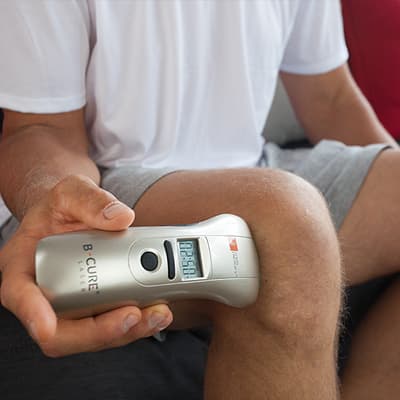Treatment of Leg Ulcers with Softlaser Device
The treatment of hard-to-heal wounds on the foot or lower leg, also known as leg ulcers, can gain new momentum. According to studies conducted with softlaser devices, softlaser treatments for leg ulcers resulted in effective wound healing. This is good news for those suffering from ulcers, as these wounds often show no signs of healing for months or even years. Shockwave therapy can also be an effective method for treating leg ulcers, as it promotes healing and improves blood circulation.
What is a Leg Ulcer?
An ulcer is the death of tissues that constitute the surface, creating a tissue deficiency (open wound) in the affected area. With traditional treatment, wounds often remained open for years. They heal very slowly and, if they do heal, are prone to recurrence.
Leg ulcers are a condition that worsens life expectancy and quality of life and also represents a serious source of infection for the entire body.
Definition of Ulcerated Wounds
An ulcerated wound is a wound that does not heal properly and persists for a long time. These wounds are usually accompanied by tissue death, causing tissue deficiency in the affected area.
Ulcerated wounds are difficult to heal and prone to recurrence, which can pose a serious infection risk for the entire body. Proper treatment of these wounds is especially important, as the lack of adequate care carries significant health risks.
Types of Ulcers
Leg Ulcer
A leg ulcer is an ulcer that forms on the lower limb, most commonly on the lower leg. This type most often develops due to venous insufficiency, arterial insufficiency, or diabetes.
Symptoms of leg ulcers include pain, swelling, redness, and unpleasant odor. Treatment of leg ulcers requires special attention as lack of proper therapy can lead to serious complications.
Diabetic Ulcer
Diabetic ulcers develop due to diabetes and most commonly appear on the toes, sole, or heel. Symptoms include pain, swelling, redness, and unpleasant odor.
These ulcers are particularly problematic because healing is slower due to diabetes, and there is a greater risk of infection. Proper control of blood sugar levels and regular medical check-ups are especially important during treatment of diabetic ulcers.
Arterial Ulcer
Arterial ulcers occur due to arterial insufficiency, most commonly appearing on the lower leg. Symptoms include pain, swelling, redness, and unpleasant odor.
Because of impaired arterial circulation, tissues do not receive enough oxygen and nutrients, slowing wound healing. Treatment involves managing circulation problems and properly caring for the wound.
Treatment of Ulcers with Softlaser
Treating ulcers places a heavy burden on the patient and their family. For success, both the wound and the underlying disease must be treated, as only then can lasting results be expected. Devices such as B-Cure, Personal Laser, and Energy Laser are all suitable for ulcer treatment. Additionally, wearing compression stockings is important to improve blood circulation and prevent the recurrence of ulcers.
Product Recommendation: Our Softlaser Devices
The primary effect of the softlaser device is to support cellular regeneration processes, thereby accelerating healing, and through stimulating endorphin production, it also provides pain relief.
Clinical studies performed with softlaser devices have proven their effectiveness in ulcer treatment. Even severe and deep diabetic ulcers (the largest treated ulcer area was 24cm²) healed during the study.
90% of treated ulcers fully closed within 8-12 weeks. In contrast, only 10% of wounds healed in the control group, which did not receive softlaser treatment.

Treatment of a severe ulcer formed at the site of toe amputation with a softlaser device resulted in successful wound closure within 8 weeks.
- The essence of softlaser treatment lies in directing the laser beam emitted by the device onto the area to be treated (holding the device there).
- The duration of treatment strongly depends on the size of the area to be treated but is generally 5-10 minutes.
- The goal is to deliver 5-8 Joules/cm² of energy into the cells, which initiates the healing process.
- Different devices deliver this amount of energy over varying times, so it is important to follow the treatment time recommendations in the user manual!
- Treatment that is too short will not initiate beneficial processes, but overly long treatment is also not good (think about sunbathing: if you stay in the sun for only 1-2 minutes, you do not warm up; if you lie out for hours, it causes sunburn).
- While in joint treatment the laser device should be placed directly on the skin, in the case of ulcers (open wounds), this is not feasible for hygienic reasons! Hold the device as close to the surface as possible.
- If the ulcer area is larger than the treatment head coverage, move the device so the entire area receives treatment.
- Treatments must be repeated daily until complete healing (in case of ulcers, this may take at least 8-12 weeks).
- Higher power devices require shorter treatment times.



